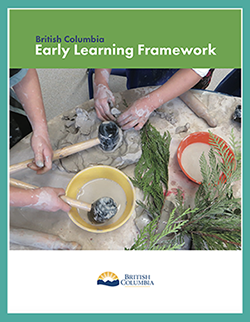Module 2: Rethinking Learning and Practice
Creating Pedagogical Narration
![]() The educators collected traces of the activities, including photos, wood, sap, sticks, and ivy.
The educators collected traces of the activities, including photos, wood, sap, sticks, and ivy.
They chose which of the many photos to share. These choices shaped how others saw this account of what happened with the children and the forest.
![]() The educators shared the photos and wrote a pedagogical narration using many of the photos.
How might they share the pedagogical narration?
The educators shared the photos and wrote a pedagogical narration using many of the photos.
How might they share the pedagogical narration?
They could
- Remind the children about their activities and invite new conversations
- Share the pedagogical narration with colleagues, family, and the community
![]() How might the educators engage in collaborative dialogue?
How might the educators engage in collaborative dialogue?
They could discuss the pedagogical narration with
- Colleagues: They can discuss ways of being in the forest. They can reflect on photos and notes.
- Families: They can share the narration, and invite many perspectives.
- Children: They may notice the ivy, collect sap for glue, build with sticks, and expand ideas of what could be created.
- The larger community: They can share the pedagogical narration at local events, meetings, or at conferences. They can also publish their pedagogical narration in a provincial journal.
Questions and discussions about these activities can lead to new areas of interest, and new pedagogical choices.
![]() The educators were paying attention to the children’s interests and made pedagogical choices to
The educators were paying attention to the children’s interests and made pedagogical choices to
- Harvest the ivy and use it to make ropes
- Use ivy and wood to make a boat
- Make forest glue with sap
- Experiment with forest glue to make snowflakes
The educators recorded these moments in a pedagogical narration.
Pedagogical narration lets you plan. It lets you extend how you and the children think and learn. Part of the process is to review and rethink your pedagogical choices and the narration. From this, you may make more pedagogical choices. You and the children are co-constructing knowledge.
